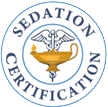Virginia Board of Nursing Review – July 8, 2021
Reviewed by Sedation Certification – January 10, 2024
State Sedation Policy – Yes
Can RN’s give sedation? – Yes
Can RN’s give Propofol/Ketamine? – Ambiguous
PDF link of the Policy seen below.
Virginia Board of Nursing
Registered Nurses and Procedural Sedation
Sedation has four identified levels: minimal (anxiolysis); moderate (conscious sedation); deep sedation; and general anesthesia. Definitions of the levels of sedation/anesthesia are:
Minimal sedation means a drug-induced state during which patients respond normally to verbal commands. Although cognitive function and physical coordination may be impaired, airway reflexes, and ventilator and cardiovascular functions are unaffected.
Moderate sedation means a drug-induced depression of consciousness, during which patients respond purposefully to verbal commands, either alone or accompanied by light tactile stimulation. Reflex withdrawal from a painful stimulus is not considered a purposeful response. No interventions are required to maintain a patent airway, and spontaneous ventilation is adequate. Cardiovascular function is usually maintained.
Deep sedation means a drug-induced depression of consciousness during which patients cannot be easily aroused but respond purposefully following repeated or painful stimulation. Reflex withdrawal from a painful stimulus is not considered a purposeful response. The ability to independently maintain ventilatory function may be impaired. Patients may require assistance in maintaining a patent airway, and spontaneous ventilation may be inadequate. Cardiovascular function is usually maintained.
General anesthesia means a drug induced loss of consciousness during which patients are not arousable, even by painful stimulation. The ability to independently maintain ventilator function is often impaired. Patients often require assistance in maintaining a patent airway, and positive pressure ventilation may be required because of depressed spontaneous ventilation or drug-induced depression of neuromuscular function. Cardiovascular function may be impaired.
It is important to first identify the purpose and level of sedation/anesthesia intended, with the acknowledgement that individuals react differently to sedation, so the registered nurse must be prepared to handle a deeper level of sedation.
Registered nurses may administer mild to moderate sedation under certain conditions according to a prescriber’s order. Administration must be in the presence of a prescriber appropriately credentialed and privileged for sedation. If the purpose is to achieve a level of deep sedation or anesthesia, there must be a qualified physician or certified registered nurse anesthetist directing the administration of the deep sedation or anesthesia.
Education and Training
In order to administer sedation, certain competencies should be demonstrated:
• Knowledge of the purpose, actions and side effects of sedating medications;
• Knowledge of the respiratory system and oxygen delivery;
• Demonstrated airway management competency;
• Understanding of cardiovascular system, medication pharmacology and antidotes, dysrhythmia recognition and sedation complications;
• Ability to initiate emergency rescue procedures and resuscitation;
• Identification and differentiation of levels of sedation and common patient assessment risk scales; and
• Competency in pre, intra and post procedural nursing care from initial assessment to discharge.
Training for the registered nurse administering medications for procedural sedation should include advanced training in airway management, treatment of cardio-respiratory complications, and advanced pharmacology training in the medications utilized.
Monitoring and documentation
The registered nurse should understand standards of monitoring and documentation including:
• Pre-sedation assessment – airway, NPO status, pregnancy, medical history, medication history, allergies, previous complications with sedation and history and physical;
• Collaboration with physician to develop sedation plan;
• Continuous monitoring to include heart rate, respiration, blood pressure, EKG, oxygenation via pulse oximetry and level of sedation; and
• Continuous monitoring into the recovery phase as the patient returns to baseline until discharge.
Document source:
Research and presentation on “RN Administered Sedation” by Ruth Williams, BSN,RN, RN-BC, VCU
Schools of Nursing, taken from a literature review, information from other states, and key reference articles.
